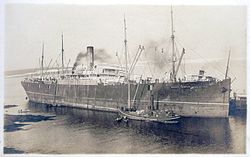Mount Temple (ship)
|
Mount Temple, which ran aground off Nova Scotia (1907)
|
||||||||||||||||||||||||
|
||||||||||||||||||||||||
|
||||||||||||||||||||||||
|
||||||||||||||||||||||||
|
||||||||||||||||||||||||
|
||||||||||||||||||||||||
The Mount Temple was a passenger ship put into service in 1901, which from 1903 belonged to the Canadian shipping company Canadian Pacific Steamship Company , which used it in transatlantic passenger and mail traffic between Great Britain and Canada . Briefly used as a troop transport during the First World War , the Mount Temple was sunk by the German auxiliary cruiser Möve on December 6, 1916, about 600 nautical miles west of the Fastnet rock .
The ship
The 8,790 GRT steamship was built at the Armstrong-Whitworth shipyard in Low Walker ( Newcastle upon Tyne ) and was launched there on June 18, 1901. It was built for the North Atlantic service of the British shipping company Elder Dempster & Company and named after William Cowper-Temple, 1st Baron Mount Temple (1811–1888), an English politician, Lord of the Admiralty and chairman of Armstrong-Whitworth. The Mount Temple was 147.8 meters long, 18 meters wide and had a draft of 9.3 meters. She was equipped with a chimney, four masts and two propellers and was powered by two triple expansion steam engines from the Wallsend Slipway Company, which developed 694 nominal horsepower and allowed a speed of 13 knots.
On September 19, 1901, the Mount Temple ran on her maiden voyage to New Orleans . From November 4, 1901, she made two trips as a troop transport in the Second Boer War . She then returned to commercial traffic between Great Britain and New Orleans until Elder Dempster & Company ceded their Canadian service and associated ships to Canadian Pacific in 1903.
With a capacity for 14 passengers in first and 1250 in third class, the Mount Temple set off on May 17, 1903 for her first Atlantic crossing from Liverpool to Quebec and Montreal . She completed seven round trips on this route. From March 27, 1904, it was implemented on the route from London via Antwerp to Saint John in New Brunswick . On December 1, 1907, the ship stranded with 600 people on board at West Ironbound Island on the coast of Nova Scotia . Passengers and crew were safely brought ashore, but the ship itself was not recovered until April 16, 1908.
After the outbreak of the First World War, the Mount Temple was drafted for service as a troop transport in September 1914, but in the following year she resumed her passenger traffic. During the war, a 75mm cannon was mounted on the stern of the ship.
Titanic incident
On the night of April 14-15, 1912, Mount Temple was 49 miles from the Titanic when it slowly sank after an iceberg collision . She was one of the closest ships to the Titanic . After the emergency of the Titanic had received that took Mount Temple course for them. However, captain James Henry Moore had his ship stopped after a short time because it was surrounded by ice and he could not ensure a safe passage.
When the Mount Temple finally arrived at the scene of the accident on the morning of April 15, the survivors had already been picked up by the Cunard steamer Carpathia . Immediately after the disaster, controversy arose over Mount Temple over its speed that night, its true position, and how far it was actually from the Titanic . It was even rumored that Captain Moore had ignored the Titanic's emergency missiles and that Mount Temple was the nearby ship whose lights the people on board the Titanic had seen on the horizon. Most sources assume that it was more likely to be the Californian freighter . However, the exact identity of this ship could never be established.
Sinking
On December 3, 1916, the Mount Temple ran under the command of Captain Alfred Henry Sargent with 116 crew members for a crossing to Liverpool with a stopover in Brest, France . On board were 710 horses for the war in France and 6250 tons of cargo, including 3000 tons of maize and 1400 boxes of eggs. In addition, 22 wooden boxes with dinosaur fossils , which the American paleontologist Charles H. Sternberg had unearthed in the Canadian province of Alberta , were stowed in the holds . They were on their way to see Sir Arthur Smith Woodward , head of the paleontology department at the British Museum in London.
Three days after departure, the Mount Temple was intercepted in the middle of the Atlantic about 1200 miles north of the Azores by the German auxiliary cruiser Möve under the command of Corvette Captain Nikolaus Graf zu Dohna-Schlodien . The Mount Temple first opened fire on the SMS Möve , which she replied. On board the Mount Temple , four crew members, three sailors and the chief steward died in the fire. After a brief struggle, the crew of Mount Temple surrendered
The more than 100 survivors of the ship were taken on board the SMS Möve , which then sank the Mount Temple with grenades . The survivors were transferred on December 12, 1916 to the British ship Yarrowdale , taken as a prize , which arrived in Swinoujscie on December 31 . The Americans among them were released in March 1917 because the United States was still a neutral country at the time. The remainder were taken prisoner of war .
The Mount Temple was the fourth of a total of 18 ships that the Canadian Pacific lost in World War I.
